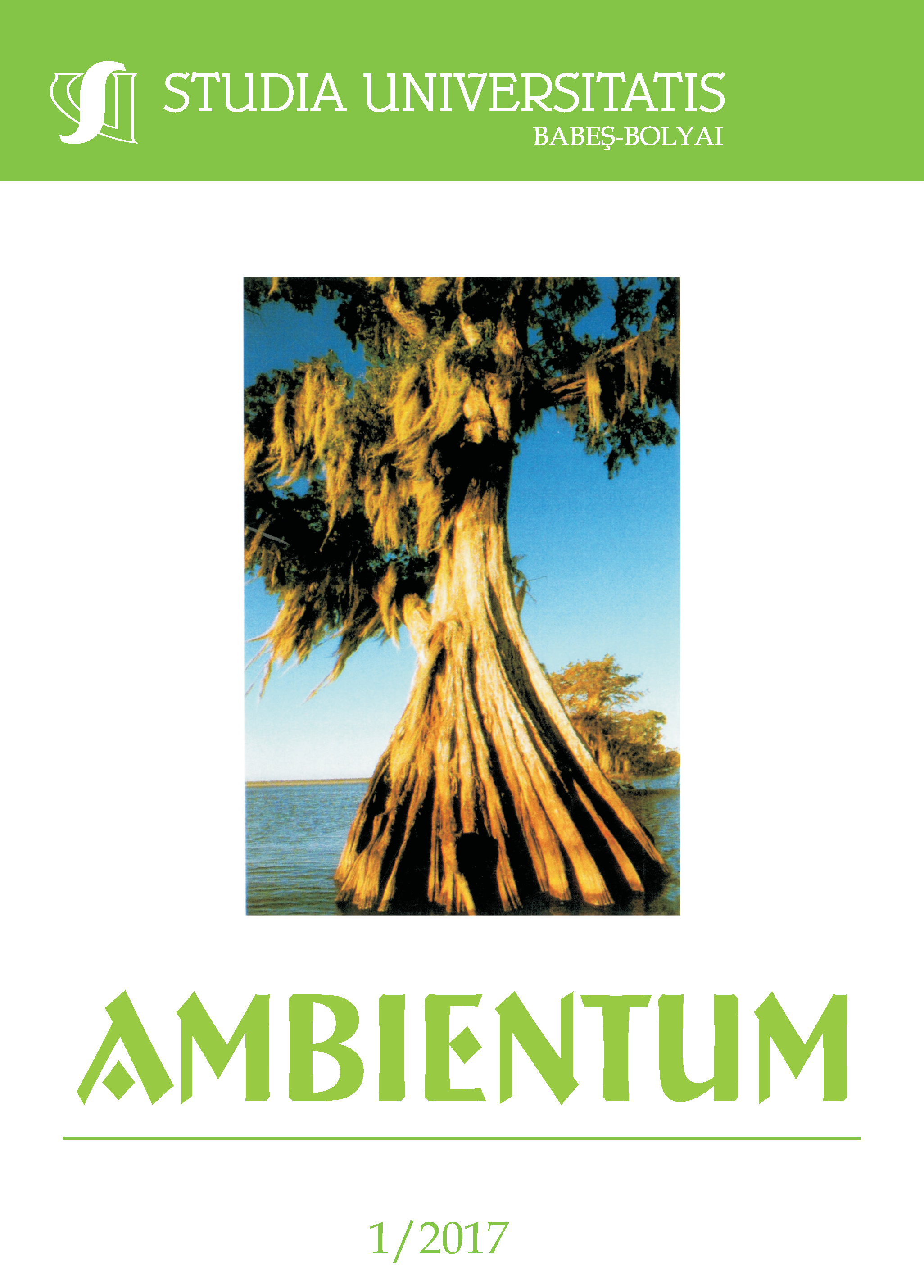IDENTIFICATION THE SOURCES OF PAHS IN CLUJ-NAPOCA’S CITY ATMOSPHERE USING MOSS AS BIOMONITORS
DOI:
https://doi.org/10.24193/subbambientum.2017.1.08Keywords:
Polycyclic aromatic hydrocarbons, urban atmosphere, moss, biomonitors, Cluj-Napoca.Abstract
This study aims to determine the concentrations of PAHs in Cluj-Napoca’s city atmosphere using moss as biomonitors. Samples from different neighborhoods of Cluj-Napoca city were collected and analyzed by gas chromatography coupled with mass spectrometry. The concentrations of individual PAHs ranged from 0.61 µg kg-1 (chrysene) to 353.6 µg kg-1 (Indeno(1,2,3 -cd)pyrene), and the ΣPAHs ranged from 92.61 µg kg-1 to 353.6 µg kg-1 with a mean value of 329.23 µg kg-1. Residential areas characterized by both low population density and traffic intensity had the lowest concentration levels of ΣPAHs in moss samples, below 200 µg kg-1. Levels of concentration between 200 and 300 µg kg-1 were obtain in similar residential areas, but with more intense traffic. The locations that had PAHs concentration levels in moss exceeding 300 µg kg-1 are either industrial areas or neighborhoods with intense traffic. In all the study’s locations the main emission source, according to PAHs diagnostic ratios, is pyrogenic, mainly originating from traffic emissions. The FL/ (FL+PYR) and FLA/ (FLA+ PYR) ratios indicate that in some cases there also is a petrogenic source. In a cross examination however, it can easily be seen that the main apportion for all the location is from pyrogenic sources.
References
Aboal J.R., Pérez-Llamazares A., Carballeira A., Giordano S., Fernández J.A., 2011, Should moss samples used as biomonitors of atmospheric contamination be washed? Atmospheric Environment, 45, pp. 6837-6840.
Ares A., Aboal J.R., Carballeira A., Giordano S., Adamo P., Fernández J.A., 2012, Moss bag biomonitoring: A methodological review. Science of the Total Environment, 432, pp. 143–158.
Ares A., Aboal J.R., Fernández J.A., Real C., Carballeira A., 2009, Use of the terrestrial moss Pseudoscleropodium purum to detect sources of small scale contamination by PAHs. Atmospheric Environment, 43, pp. 5501–5509.
Capozzi F., Giordano S., Aboal J.R., Adamo P., Bargagli R., Boquete T., Di Palma A., Real C., Reski R., Spagnuolo V., Steinbauer K., Tretiach M.,Varela Z., Zechmeister H., Fernández J.A., 2016a, Best options for the exposure of traditional and innovative moss bags: A systematic evaluation in three European countries. Environmental Pollution, 214, pp. 362-373.
Capozzi F., Giordano S., Di Palma A., Spagnuolo V., De Nicola F., Adamo P., 2016b, Biomonitoring of atmospheric pollution by moss bags: Discriminating urban-rural structure in a fragmented landscape. Chemosphere, 149, pp. 211-218.
Directiva 2004/107/CE a parlamentului european și a consiliului (http://www.mmediu.ro/app/webroot/uploads/files/Directiva%202004_107_CE%282%29.pdf)
Forbes P.B.C., van der Wat L., Kroukamp E.M., 2015, Chapter 3 - Biomonitors. Comprehensive Analytical Chemistry, 70, pp. 53-108.
Harmens H., Foan L., Simon V., Mills G., 2013, Terrestrial mosses as biomonitors of atmospheric POPs pollution: A review. Environmental Pollution, 173, pp. 245-254.
Holoubek I.,Kořínek P., Šeda Z., Schneiderová E., Holoubková I., Pacl A., Tříska J., Cudlín P., J. Čáslavsky J., 2000, The use of mosses and pine needles to detect persistent organic pollutants at local and regional scales. Environmental Pollution, 109, pp. 283-292.
Iodice P., Adamo P., Capozzi F., Di Palma A., Senatore A., Spagnuolo V., Giordano S., 2016, Air pollution monitoring using emission inventories combined with the moss bag approach. Science of the Total Environment, 541, pp. 1410–1419.
Lazić L, Urošević M.A., Mijić Z., Vuković G., Ilić L., 2016, Traffic contribution to air pollution in urban street canyons: Integrated application of the OSPM, moss biomonitoring and spectral analysis. Atmospheric Environment, 141, pp. 347-360.
Liu X., Zhang G., Jones K.C., Li X., Peng X., Qi S., 2005, Compositional fractionation of polycyclic aromatic hydrocarbons (PAHs) in mosses (Hypnum plumaeformae WILS.) from the northern slope of Nanling Mountains, South China. Atmospheric Environment, 39, pp. 5490–5499.
Marć M., Tobiszewski M., Zabiegała B., Guardia M., 2015, Current air quality analytics and monitoring: A review. Analytica Chimica Acta, 853, pp. 116–126.
Oprea C.D., Mihul Al., 2003, Accumulation of specific pollutants in various media in the area affected by a petrochemical center. Romanian Reports in Physics, 55 (2), pp. 82 – 90.
Tarcău D., Cucu-Man S., Boruvkova J., Klanova J., Covaci A., 2013, Organochlorine pesticides in soil, moss and tree-bark from North-Eastern Romania. Science of the Total Environment, 456–457, pp. 317–324.
Thomas W., 1986, Representativity of Mosses as Biomonitor Organisms for the Accumulation of Environmental Chemicals in Plants and Soils. Ecotoxicology and Environmental Safety, L, pp. 339-346.
Thomas W., Rühlingt A., Simon H., 1984, Accumulation of Airborne Pollutants (PAH, Chlorinated Hydrocarbons, Heavy Metals) in Various Plant Species and Humus. Environmental Pollution (Series A), 36, pp. 295-310.
Thomas W., Simon H., 1985, Classification of plant species by their organic (PAH, PCB, BHC) and inorganic (heavy metals) trace pollutant concentrations. The Science of the Total Environment, 46, pp. 83-94.
Viskari E.L., Rekilä R., Roy S., Lehto O., Ruuskanen J., Kärenlampi L., 1997, Airborne pollutants along a roadside: Assessment using snow analyses and moss bags. Environmental Pollution, 97 (1-2), pp. 153-160.
Vuković G., Urošević M.A., Goryainova Z., Pergal M., Škrivanj S., Samson R., Popović A., 2015, Active moss biomonitoring for extensive screening of urban air pollution: Magnetic and chemical analyses. Science of the Total Environment, 521–522, pp. 200–210.
Wang Z., Ma X., Na G., Lin Z. Ding Q., Yao Z., 2009, Correlations between physicochemical properties of PAHs and their distribution in soil, moss and reindeer dung at Ny-Ålesund of the Arctic. Environmental Pollution, 157, pp. 3132–3136.
Wegener J. W. M., van Schaik M.J.M., Aiking H., 1992, Active biomonitoring of polycyclic aromatic hydrocarbons by means of mosses. Environmental Pollution, 76, pp. 15-18.
Wu Q., Wang X., Zhou Q., 2014, Biomonitoring persistent organic pollutants in the atmosphere with mosses: Performance and application. Review. Environment International, 66, pp. 28–37.
Tobiszewski M., Namiejnik J., 2012, Review. PAH diagnostic ratios for the identification of pollution emission sources. Environmental Pollution, 162, pp. 110-119.
Downloads
Published
How to Cite
Issue
Section
License
Copyright (c) 2017 Studia Universitatis Babeș-Bolyai Ambientum

This work is licensed under a Creative Commons Attribution-NonCommercial-NoDerivatives 4.0 International License.





 ISSN (online): 2065-9490 | ISSN (print): 1843-3855 | ISSN-L: 2065-9490
ISSN (online): 2065-9490 | ISSN (print): 1843-3855 | ISSN-L: 2065-9490